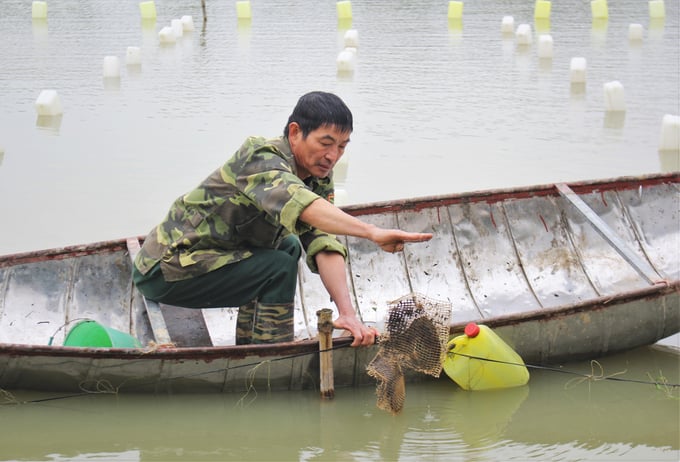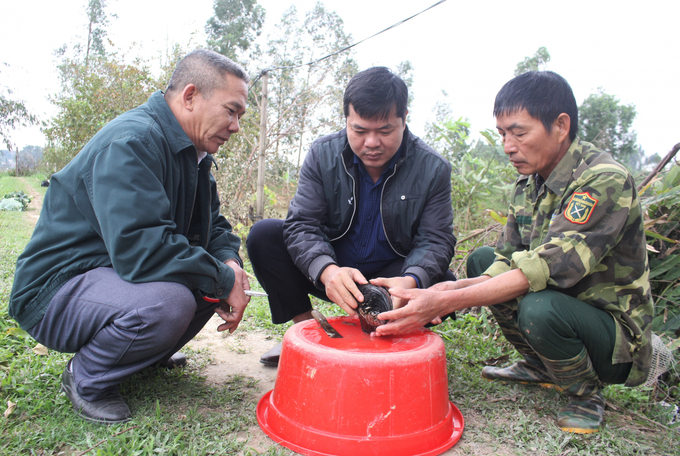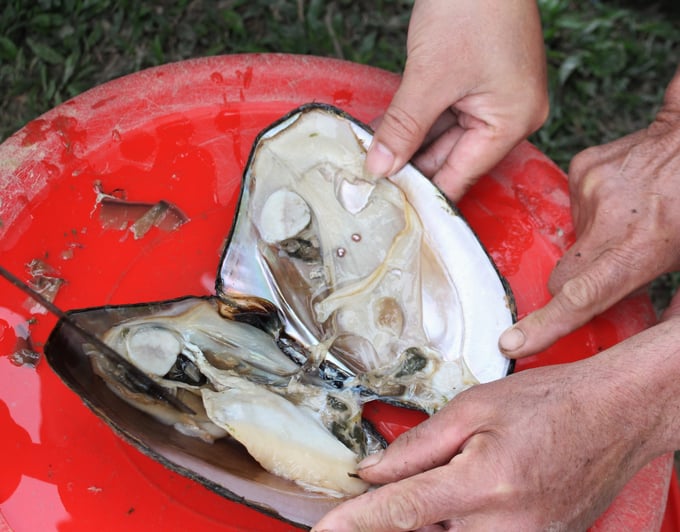Vinh Phuc is a place with natural conditions, water surface potential as well as aquatic ecosystems very suitable for the development of freshwater aquatic species. This is also considered a favorable condition for the development of freshwater mussel farming for pearls in combination with other aquaculture.
In order to realize this potential, the Vinh Phuc Agricultural Extension Center has implemented the central agricultural extension project “Construction of Pearl Cultivation Model for Domestic and Export Markets” with the support of the National Agricultural Extension Center. The project will be implemented from 2021 – 2023 with a scope of 2.1 ha in 21 households (0.1 ha per household), the number of pearl mussels is 52,500.

Mr. Nguyen Van Vien from Xuan Residential Group, Belgium, Gia Khanh City (Binh Xuyen, Vinh Phuc) is excited as the boys growing pearls grow and develop very well. Picture: Trung Quan.
Mr. Duong Van Phuong, Head of Information and Propaganda Department (Vinh Phuc Agricultural Extension Center), Project Manager shared: The aim of the project is to use the water surface of ponds and lakes to develop pearl farming. Accordingly, the project will be implemented on an area of 0.6 ha in 6 households in Lap Thach and Tam Duong districts (15,000 sons) in the period from 2021 to 2022. In the period from 2022 to 2023, the project will be used on an area of 1.5 ha in 15 households in the districts of Yen Lac, Vinh Tuong and Binh Xuyen (37,500 animals).
According to Mr. Phuong, mussel farming mainly uses the bottom of the pond, so it can be combined with other aquatic products to make the most of the water layers in the body of water.
The successful implementation of the freshwater mussel farming model for pearls will show a new direction for aquaculture farmers who focus on exploiting the maximum potential of the water surface to produce valuable goods and create jobs for the people.
Raising mussels does not require much care. Pearl is a very popular product in domestic and overseas markets with high selling prices, so farmers don’t have to worry about consumption as the market is very open; After collecting pearls, mussel meat is used as food or fodder for livestock…
Mr. Nguyen Van Vien from Xuan Residential Group Belgium, Gia Khanh City (Binh Xuyen, Vinh Phuc), who is participating in the project, said: His family has a 10,000 m2 fish pond with natural food (grass, vegetables, etc.) that annually the market is supplied with 3-4 tons of fish of all kinds. When he was briefed on the project by the town’s agricultural staff, he realized that he could use the available water area to combine shellfish farming for pearls and increase his income, and enthusiastically signed up to take part.

Officials from the Vinh Phuc Agricultural Advisory Center will come down regularly to assist households participating in the model in assessing growth and development indicators for mussels and pearls. Picture: Trung Quan.
According to Mr. Vien, technical staff from Vinh Phuc Agricultural Advisory Center and related units came before the stocking to take samples for testing and carefully check the water source in the family ponds. In addition, he was mentored and trained in pearl shellfish farming techniques, provided high-quality seeds, and was supported with 50% of the cost of breeding animals and microbial products for water treatment.
During rearing, special attention must be paid to the pond water to avoid chemical influences and sources of entry into the pond. All the clams are fixed in a mesh bag and hung on a float, this helps the clams not to deviate, so the pearl is round and beautiful, and the algae and plankton stick to the net better, creating a diversified food. However, it is necessary to regularly inspect and clean the mussel farming bag to remove algae and other living organisms, minimize disease, and ensure mussel growth.
To date, more than 2,500 sons have inherited Perlen from his family in the last 12 months, all have grown and developed well. Every week, he regularly checks the water source, the survival rate and the growth rate of the mussels, keeps a diary under the guidance of the technical staff. In addition, Vinh Phuc Agricultural Extension Center technical staff will come every 3 months to inspect and dissect shellfish to check pearls. The results of the last test showed that the mussel survival rate reached 96%, the pearl keeping rate was high. The young can probably be harvested after 24 months.
In terms of consumption, Mr. Vien said that since it is a new grower, Vinh Phuc Agricultural Extension Center will help connect with pearl-buying units and companies to sign sales contracts with other companies.Households who participate in the model.

Farming freshwater mussels for pearls helps to make the most of the water surface and increase people’s income. Picture: Trung Quan.
Mr. Duong Van Phuong, Project Manager, added: The results of the models in 2021-2022 show that the achieved technical indicators are higher than the initially set targets: the shellfish survival rate reached 81.6%; seed retention rate 71.1%; The proportion of jade of type I is 5.3%, grade 2 21.1%, grade 3 25.7%, grade 4 31.3% and jade grade 5 16.6%. Profit from 0.6 ha of freshwater mussel farming for pearls reached nearly VND 300 million.
So, households use the water surface to raise fish to raise more freshwater clams for pearls. In addition to the profit from fish stocking, the profit from clam farming is VND 49.1 million/0.1 ha. Also, since each clam is compared with a circulating water purifier, it has helped to make the pond environment, especially the water source, cleaner.

